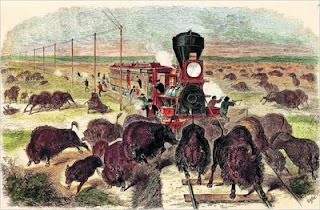सांग् गो चेड्वा दिस्तां कसो, खंडळ्याचो घाट.
Michael Kazin has written a review of "RAILROADED / The Transcontinentals and the Making of Modern America" By Richard White for The New York Times July 15 2011:
"...“Transcontinental railroads,” he asserts in “Railroaded,” “were a Gilded Age extravagance that rent holes in the political, social and environmental fabric of the nation, creating railroads as mismanaged and corrupt as they were long.”..."
"...To gain an edge on their corporate rivals, railroad owners built expensive lines into drought-prone areas that had few settlers and little prospect of attracting more. To finance their risky endeavors, they routinely bribed politicians and borrowed money they could not pay back — while publishing mendacious financial reports. To insure friendly coverage, railroad executives bankrolled local newspapers and arranged to kill or delay the publication of stories that might damage their interests. At the helm of a dangerous industry where workplace accidents were common, they resisted installing air brakes and other devices that would have sharply reduced the toll of maimings and deaths..."
Sounds so eerily familiar in today's India.
"...In contrast, Charles Francis Adams Jr., the head of the Union Pacific, regarded himself as a genteel intellectual. The grandson and great-grandson of presidents was merely dabbling, temporarily, in the biggest industry in the land, which he vowed to reform. Adams scorned the venality of his fellow railroad bosses. “Our method of doing business is founded upon lying, cheating and stealing — all bad things,” he remarked..."
Oh how we miss Mr. Adams' frankness in today's India?
"...But White calls Huntington and his ilk “men in octopus suits.” He views them as 19th-century equivalents of the profit-mad, short-sighted financiers who recently undermined economies on both sides of the Atlantic. Both transcontinental railroad managers then and the Wall Street bankers in our time ran “highly leveraged operations” that “depended on continued borrowing to meet their obligations.” Both groups made it rich because they had powerful enablers in Washington..."
Conflict of interest?
"...Grover Cleveland, the Democrat who sat in the White House during the depression of the 1890s, intoned, “Though the people support the government, the government should not support the people.” Yet, in 1894, Cleveland’s attorney general, Richard Olney, rushed to court to bust a national strike by railroad workers who were expressing solidarity with a walkout by employees of the Pullman sleeping car company. With a federal injunction in hand, Cleveland ordered thousands of American troops to break the strike and arrest its leaders. At the time, the attorney general was on the payroll of at least one major railroad company..."
"...At the end of his powerful book, crowded with telling details and shrewd observations about nearly every aspect of the world the railroad bosses made, White floats a counterfactual balloon: what if the steel lines that spanned the continent had been “built as demand required” instead of as part of a competitive dash that caused as much waste and hardship as progress? Slower, more rational development would have lessened the damage to the environment, given Native Americans a chance to adapt to conquest and perhaps saved thousands of lives. White advises, “We need to think about what did not happen in order to think historically.”
Such an alternative past would probably require a different country. The history of American capitalism is stuffed with tales of industries that overbuilt and overpromised and left bankruptcies and distressed ecosystems in their wake: gold and silver mining, oil drilling and nuclear power, to name a few. The railroad barons wielded more power than other businessmen in the Gilded Age. But their behavior revealed a trait they shared with many of their fellow citizens: too much was never enough."
Meanwhile what happened in British India?
Matthew Engel has reviewed "Blood, Iron and Gold: How the Railways Transformed the World" by Christian Wolmar for Guardian November 29 2009:
"...The narrative takes on its most epic quality in the United States; its most stupid in Australia (where the different states set about building a charming variety of gauges without a thought about what would happen when you tried to link them up); and its most brutal in India, where maybe 25,000 workers died building the line through the Western Ghats alone..."
Yes, the same Ghat in this lovely song...
हिरव्या हिरव्या रंगाची, झाडि घनदाट
सांग् गो चेड्वा दिस्तां कसो, खंडळ्याचो घाट.
We too need to think about what did not happen in order to think historically.
There is a strong counter-point to these arguments in The New York Times, July 27 2011 "The World as America Dreamed It":
"...But there was something quite different about much 19th-century American culture. The Industrial Revolution was not repelled but embraced; it was often seen not as an intrusion but as an offering of possibility. It brought miseries but also innovations. It did not overturn the natural world, it seemed to coexist with it...
...There are paintings here, for example, showing newly built railway lines puffing smoke. Those engines appear not as threats but as features of the pastoral landscape..."

Artist: Ernest Griset
"The Far West-Shooting Buffalo on Line of the Kansas-Pacific Railroad", Frank Leslie’s Illustrated Newspaper, June 3 1871.
Credit: Smithsonian American Art Museum
Next time I am on a train, climbing Khandala ghat, taking in a million-dollar view and the train stops without an apparent reason, I might hear echoes of dying screams of men and women.
Q: सांग् गो चेड्वा दिस्तां कसो, खंडळ्याचो घाट?
A: रक्त लाल रंगाचा दिस्तां खंडळ्याचो घाट
No comments:
Post a Comment